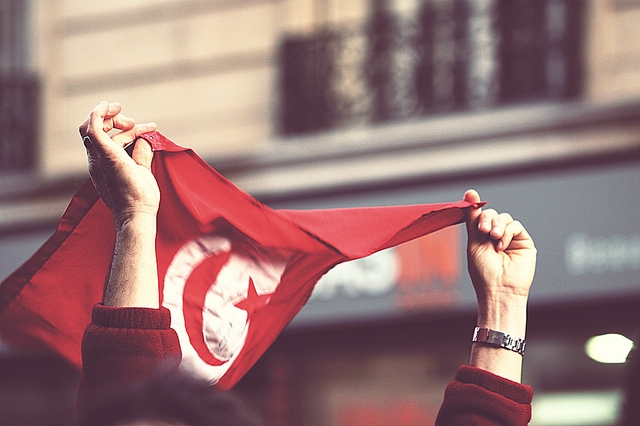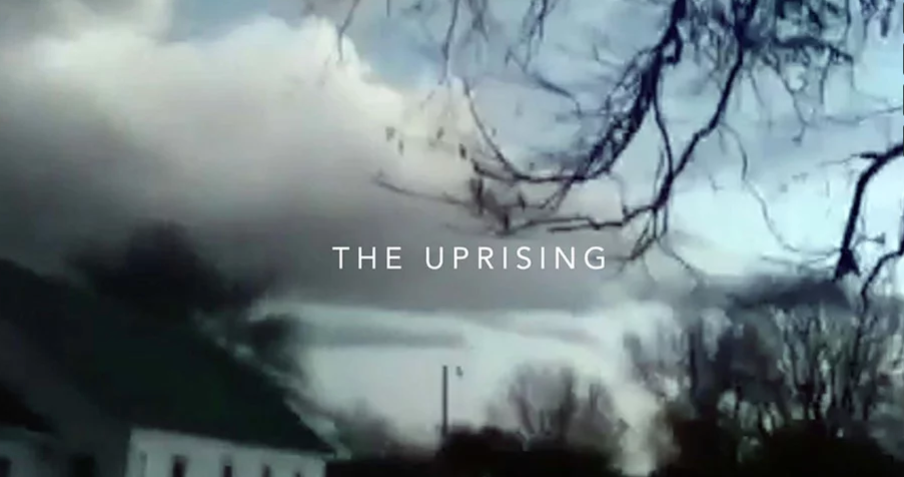"The Uprising:" The Arab Spring Through The Lenses of Citizen Journalists

On November 15th, film director and journalist Peter Snowdon presented his 2013 film, "The Uprising" at AUP. Composed entirely of cell phone shot videos made by both citizens and residents of Bahrain, Egypt, Tunisia, Syria, Libya, and Yemen, the film uses real footage providing a unique, truly raw perspective of the Arab Spring Revolutions from the inside, the footage left uncorrupted by different media outlets.
Tahrir Flags. Image Credit: Flickr/ AK Rockefeller
The Arab Spring, often referred to as the Arab Revolutions was a revolutionary rise of both peaceful and violent demonstrations, coups, riots, and protests starting in North Africa and spread across the Middle East. The first of many revolutions officially started on December 17th, 2010 in Tunisia. Inspired by the effect of the Tunisian revolution, more coups, riots and street demonstrations soon spread to other Arab countries: Libya, Egypt, Yemen, Syria, and Bahrain. By 2012, the initial wave of revolutions in these countries dwindled met with brutal responses from government authority and counter-demonstrators. Several widespread conflicts ensued, including the Syrian Civil War, the Libyan Civil War, and the Yemeni crisis.
"Some of these videos, I thought were kind of amazing. I began to become fascinated by these videos myself."
Screened at film festivals worldwide, "The Uprising" creates an imaginary, sequential pan Arab revolution through real online videos shot and uploaded to platforms such as YouTube by the individuals protesting in the Arab Spring. Award-winning director Peter Snowdon worked as a journalist in Egypt for several years between 1997 and 2000 and as a filmmaker in Palestine. Despite the wide success of his film, Snowdon admits that "It wasn't originally about the video." As years passed and the Arab Spring continued to revolutionize, Snowdon began to see an extensive amount of protest videos, not just on social media. "Some of these videos, I thought were kind of amazing. I began to become fascinated by these videos myself." From this fascination, grew the prospect of making an anthology of videos– and that with extensive research, grew bit by bit into the film that it is today.
"The Uprising." Image Credit: Vimeo/Bruno Tracq
"I spent probably somewhere between 500 and 1000 hours watching these videos," Snowdon says. "I downloaded about 10 percent of it." Although virtually impossible to know who made the videos, especially in countries such as Syria and Bahrain, Snowdon spent hours spent sifting through YouTube, privately contacting video authors through their YouTube accounts. "At the time that I was working on this in 2011 through 2012, there was not a strong property culture. There was an element in these revolutions that was hostile to the idea of intellectual property. I sent YouTube messages to everybody that I felt I could do so without putting them at risk by doing so, and where I was reasonably confident that they actually made the video. It's different places, Snowdon says. In Egypt, people were far more identifiable than in Syria, for instance." In countries like Syria and Bahrain, many of the videos were uploaded in a way to make the person who designed or took the video completely untraceable, thus protecting their safety as a citizen.
"The videos are very immediate, very raw in some sense. They give a basic sense of what it is to move through the world with a camera."
Although a filmmaker, Snowdon did not film any of "The Uprising" himself. As a result of the entirety of the film through the eyes of citizen journalists, each of the major players in the revolutionizing of their prospective countries, "the videos are very immediate, very raw in some sense. They give a basic sense of what it is to move through the world with a camera," Snowdon describes.
"The Uprising." Image Credit: Vimeo/Bruno TracqThe rather new, post-digital revolution concept of "citizen journalism" is based upon the idea of public citizens playing an active, journalistic role in the reporting, broadcasting, and analyzing of important news an information. With the development of the smartphone, virtually anyone has the ability to be a citizen journalist, simply by uploading pictures or videos of the news onto the internet or onto social media. Simply put, any public citizen could essentially become one of the most important journalists in the world, being in the right place at the right time. These blurry, low-quality cell phone videos from citizen journalists give way to some of the rawest, real coverage of events such as the Arab Spring.
"Some people find aspects of the film violent, even unacceptably violent."
Despite the films global success, "It's been very hard to show it officially in the Arab countries," Snowdon says. "By the time we finished the film in 2013, the situation had changed dramatically, certainly in Egypt and also in other countries." Most of the screenings have been in France and the US. The reception and response to "The Uprising has been much more supportive in the US. "But this could be just because Americans are more polite," Snowdon jokes. "But some people find aspects of the film violent, even unacceptably violent."
On the contrary, the raw, occasionally violent footage shown in "The Uprising" gives way to the real, uncensored Arab Spring, providing viewers with an undiluted image of the real actors and events of this revolutionary time in history.
The Uprising - Trailer (English) from Bruno Tracq on Vimeo.










